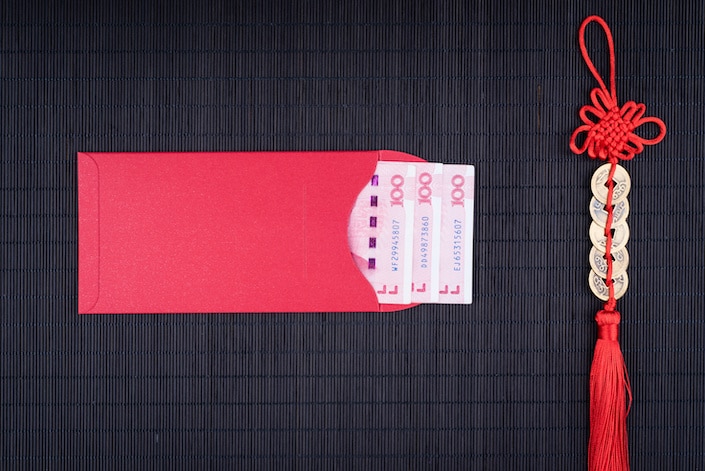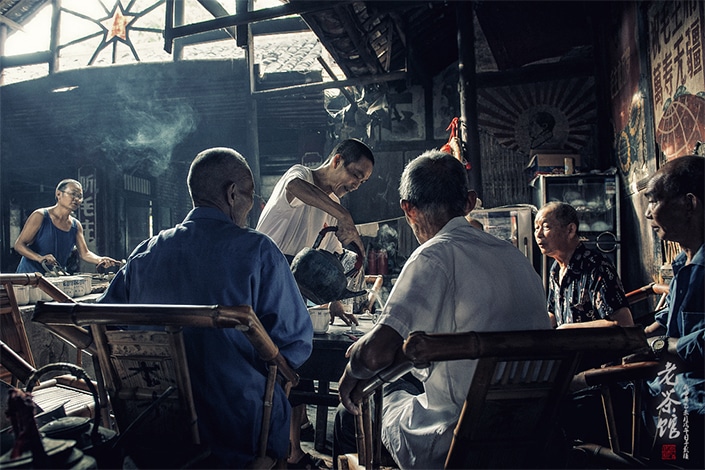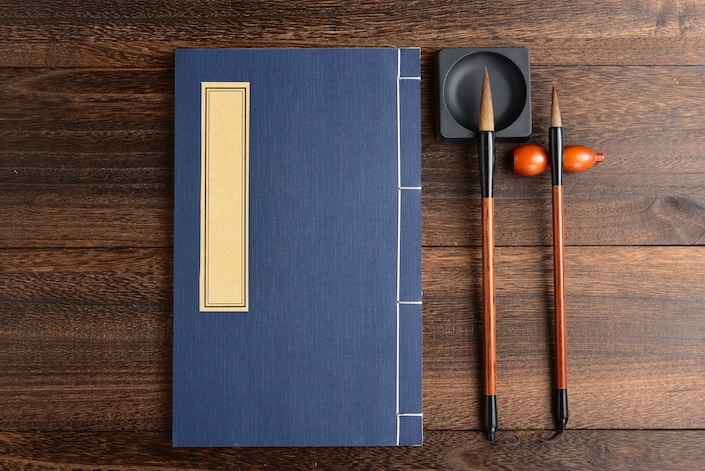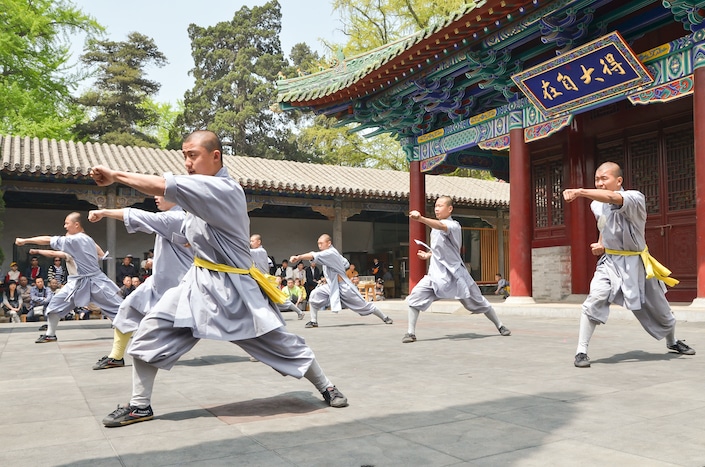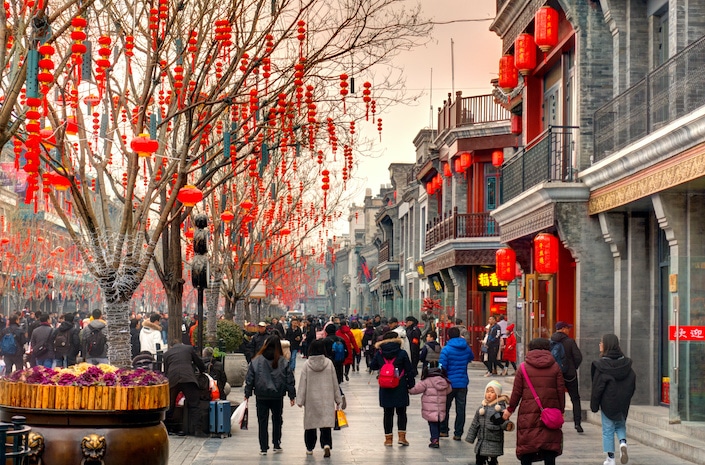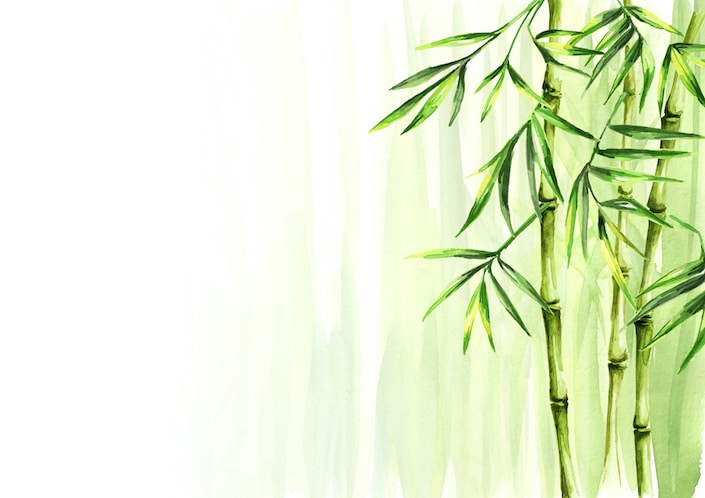What is Feng Shui: A Brief Guide
Learn Chinese in China or on Zoom and gain fluency in Chinese!
Join CLI and learn Chinese with your personal team of Mandarin teachers online or in person at the CLI Center in Guilin, China.
What is feng shui? In this article, we are going to learn about the principles of feng shui, its history and its role in modern Chinese culture.

Table of Contents
What is feng shui?
The word “feng shui” is a combination of the Chinese words for wind (风 fēng) and water (水 shuǐ), and can roughly be translated as “the way of wind and water.” Feng shui is an ancient Chinese philosophical concept based on the idea of “conscious occupation” and the harmonization of space, with the aim of bringing positive energy and influence to the people who occupy space in the world.
Yang energy, which is traditionally associated with males, is said to be active and light, while Yin, or “female,” energy is said to be dark and passive. Together, Yin and Yang represent the duality of opposite forces that make up everything in the universe.
Feng shui principles represent a blueprint that, if followed, can help balance and create harmony between these vital energies.
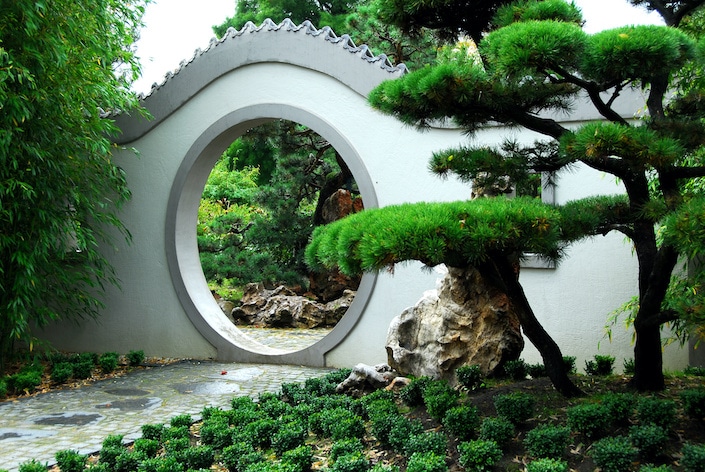
Feng shui principles have been used for centuries to create harmonious indoor and outdoor environments.
The history of feng shui and its ancient traditions
There is some debate when it comes to the origins and history of feng shui. However, what is clear is that its history spans at least 3,000 years. In fact, this concept may even have been utilized as long as 6,000 years ago.
Feng shui is quite a complicated discipline, a geomancy with an incredibly long history tightly interwoven with Chinese astrology and metaphysics. Some scholars have also argued that feng shui symbols can be found in Taoism and Buddhism, suggesting that its history is bound up with that of these ancient belief systems.
Feng shui and the Chinese compass
For centuries, the Chinese believed that there were invisible forces at work all around us. Later, they understood that these invisible forces corresponded with the magnetic forces of the Earth.
This realization led to one of the greatest inventions in human history: the magnetic compass, or 罗盘 (luópán), also called the “feng shui compass.”
Although initially used as a tool for divination, the Chinese magnetic compass was later adopted for navigation by the Song Dynasty during the 11th century. Today, the traditional Luopan is still used by feng shui practitioners to determine the best location of objects.

The Chinese originally invented the compass as a tool for use in feng shui.
Feng shui in tomb location
Some of the earliest references to feng shui can be traced back to the Zhou dynasty (1122 BCE), when it was used for determining ideal locations for burial sites. This practice is still used today, with practionisers using the Chinese compass to find the best location for a person’s grave.
Many people believe that choosing the right position for one’s grave can bring blessings for one’s posterity. Choosing a poor location, however, can bring misfortune on future generations.
Auspicious locations were thought to be those with good Qi flow. One of the general principles used to choose such an auspicious location in feng shui is “lean against mountains and face waters,” so many tombs are built on or near mountains overlooking water.
The Ming Xiaoling Mausoleum and the Sun Yatsen Mausoleum, both located in Nanjing, are good examples of tombs built according to traditional feng shui principles.
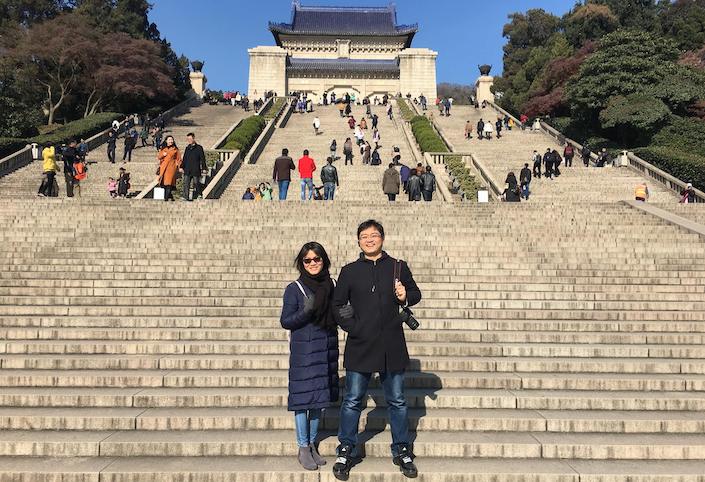
The Sun Yatsen Mausoleum in Nanjing was built according to feng shui principles.
Feng shui in construction
Feng shui was and still is used to determine the ideal location of buildings and other sites, such as gardens, as well as their layout. Those planning a construction project should first take into consideration the location of the land, the area surrounding it and the direction that each proposed structure and its windows face.
Feng shui places great importance on symmetry in architecture. A good example of this use of the concept can be seen in the construction of The Forbidden City.
In accordance with feng shui principles, The Forbidden City was built on a main axis running from north to south, with the main front entrance facing south which was deemed an auspicious direction by the feng shui masters at the time. All buildings within the city were also symmetrically arranged on either side of the axis in order to create a harmonious flow of Qi.
Feng shui principles have also traditionally been used to design outdoor spaces in China. The classical Chinese gardens in Suzhou are very good examples of the application of feng shui concepts in landscaping.
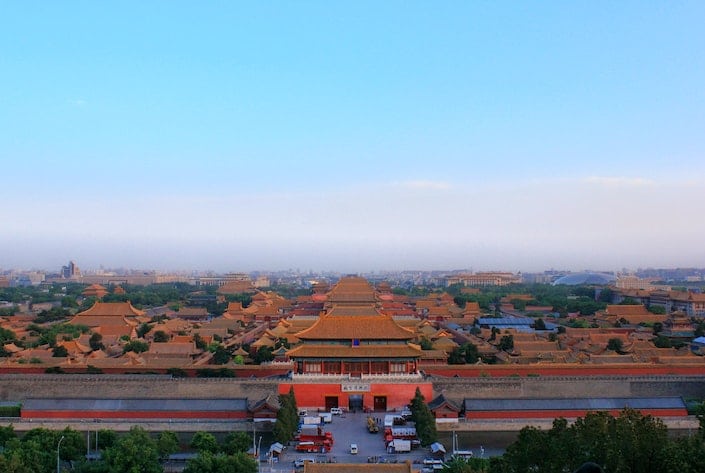
The Forbidden City is a good example of the use of feng shui in traditional Chinese architecture.
Practice of feng shui today
Today, the ancient concept of Feng Shui continues to enjoy widespread popularity, both within China and in many other countries around the world.
Feng shui in modern China
Feng shui principles are still widely used in China today to determine the ideal location for tombs and buildings. Feng shui principles are also often used in interior design. These practices are still quite prevalent amongst older Chinese people and play an important role in modern Chinese culture.
When designing or buying a home, many people take into account the direction and positioning of the building with the goal of optimizing them according to feng shui principles.
Some may even hire a professional feng shui master (风水师傅 fēngshuǐ shīfù) to advise on the most auspicious layout and design of their home or office space in order to ensure optimal luck and a harmonious environment.

People in modern China still consult feng shui masters in certain situations.
Masters and skyscrapers
For example, if called on for advice regarding a new office building for a business, a feng shui master might give suggestions on how to decorate, the location of the building itself, where to situate the boss and their office, where to place the entrances and the reception and how much green space to utilize. It is believed that with these principles in place, the business will be able to receive prosperous energy which will ensure a smooth business operation.
Although some skeptics (especially among younger generations) may disregard feng shui as pure superstition, many Chinese people still design their homes and public spaces with its principles in mind. Its presence can still be seen reflected in the architectural design of both traditional and modern building units.
Some of the most prominent examples of the use of feng shui in modern Chinese architecture can be found in Hong Kong, where feng shui concepts were used to design iconic buildings like the HSBC Building and the Bank of China Tower.
Feng shui is also still utilized in modern China to find suitable burial sites. Tomb location is still incredibly important and many still believe that a grave's characteristics can influence a family for generations.
Some people in China today may even consult a feng shui master to move their ancestor’s tombs if they believe that the feng shui in the existing tomb location is creating bad luck for the family.

Feng shui principles were used in the construction of many of Hong Kong’s most iconic buildings.
Popularity outside of China
Feng shui has been gaining popularity outside of China for many years, and its influence is continuing to grow. Feng shui is no longer merely about the movement of Qi, but it represents a kind of clean and minimalist aesthetic.
Over the years, the popularization of “minimalism” in the west has greatly influenced the way people interact with their spaces. Many are becoming more aware about the important role that one’s environment plays in regulating mood and providing a relaxing experience.
Feng shui and interior design
Although feng shui was traditionally most commonly used in China to determine ideal locations for tombs and buildings, it can also be applied to interior design. Outside of China, using feng shui principles in interior design has become increasingly popular since it is believed that doing so can create positive effects for the people within an occupied space.
Modern feng shui practitioners use several methods and theories borrowed from traditional Chinese feng shui practices to achieve their aims:
Bagua energy map
The bagua map (八卦图 bāguàtú) is an octagon shaped energy map that consists of eight areas around a center. It functions as an energy grid that is used as a blueprint to design floor plans for any sort of space.
In order to decorate a home in accordance with feng shui principles, the bagua map is placed over the floor plan, with the bottom of the bagua map aligned along the same axis as the front door or main entrance. This way, you can see which parts of the house are covered by each bagua area.
Each bagua area has different attributes associated with it and you can “activate” an area by bringing in its specific color, element or shape. Each bagua also has a trigram associated with it. These trigrams are ancient Chinese symbols that originated from the Yi Ching (易经; The Book of Changes). Each trigram is represented by 3 lines, and the length of the lines also determine whether the given area is Yin or Yang dominant.
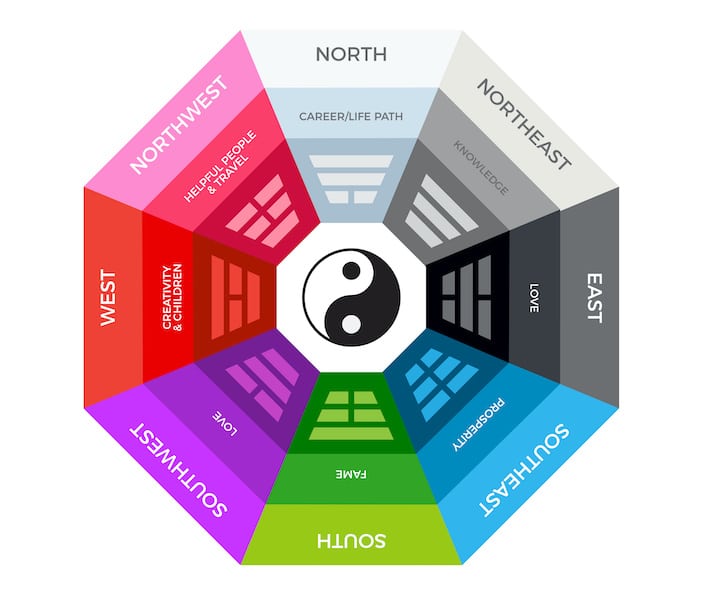
In recent years, the use of bagua maps has become popular among some western interior designers.
Bagua maps can be layered to cover different floors, but the main room or area of a house or building will need to be done first. Each bagua area is split into the following:
1. 離 Lí
- Direction: South
- Element: Fire
- Life area: Fame & Reputation
- Colors: Red
- Trigram symbol: ☲
2. 坤 Kūn
- Direction: Southwest
- Element: Earth
- Life area: Love & Partnerships
- Colors: Pink
- Trigram symbol: ☷
3. 兌 Duì
- Direction: West
- Element: Metal
- Life area: Children and Creativity
- Colors: White
- Trigram symbol: ☱
4. 乾 Qián
- Direction: Northwest
- Element: Metal
- Life area: Travel
- Color: Gray
- Trigram symbol: ☰
5. 坎 Kǎn
- Direction: North
- Element: Water
- Life area: Career & Path in Life
- Colors: Black
- Trigram symbol: ☵
6. 艮 Gèn
- Direction: Northeast
- Element: Earth
- Life area: Knowledge & Self-Cultivation
- Colors: Dark Blue
- Trigram symbol: ☶
7. 震 Zhèn
- Direction: East
- Element: Wood
- Life area: Family & Health
- Colors: Green, Blue, Teal
- Trigram symbol: ☳
8. 巽 Xùn
- Direction: South East
- Element: Wood
- Life area: Wealth & Abundance
- Colors: Purple
- Trigram symbol: ☴
Command position
In any given space, the command position is the spot that is the furthest from the door and not in direct line with it (basically located diagonally opposite, but still facing, the door).
In order to set up the command position in your home or any other space, the most important piece of furniture (such as your bed or desk) needs to be positioned diagonally across and facing the entrance of the room.
The command position is powerful and symbolic. It puts you in the best position to deal with whatever might “come through the door.” This is because you can see the doorway without being in direct line with it, which gives you enough time and space to mentally and physically prepare for any challenges that may arrive.

Many believe that applying feng shui concepts like command position can improve the energy flow in built environments.
A simple example
Taking what we have learned about the principles of feng shui above, you can see how a room may be decorated in order to optimize its energy.
For example, when using a bagua map over a floor plan, a bedroom might fall under the East (震 Zhèn) area.
Since the Zhen area is associated with the wood element and the colors blue and green, the room may have a wall or numerous objects that contain a variety of green and blue colors. A small tree plant (such as a bonsai or bamboo plant) or other woody elements (such as a wooden sculpture or a bed with a wooden frame) may also be placed in the room.
The bed would also be placed in the command position, meaning that it would be diagonally opposite (but facing) the bedroom door. One of the easiest ways to change feng shui in a room is to add or move one of the five elements associated with the location of the room.
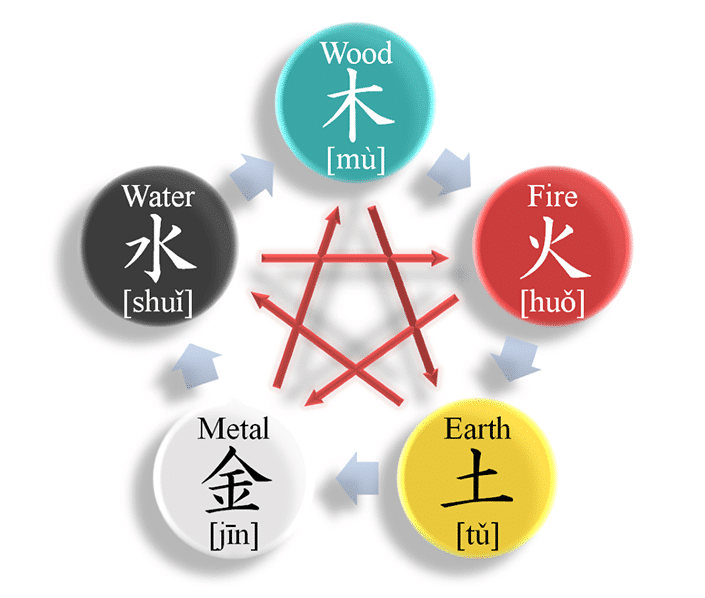
Creating the right balance among the five elements is important in feng shui.
The beauty of feng shui
Whether you are a firm believer or an absolute skeptic, feng shui can be a fun way to bring traditional Chinese culture into your home and create a calming environment at the same time.
At its core, feng shui is more than just creating a harmonious space using elements and colors. It's about existential mindfulness, being attuned to one’s environment, and acknowledging the presence of the life force energy and metaphysical elements that surround us, but go unnoticed every day.
View this post on Instagram
Feng shui vocabulary
| Chinese | Pinyin | English |
|---|---|---|
| 气 | qì | vital energy force forming part of any living entity |
| 八卦图 | bāguàtú | bagua map |
| 形而上学 | xíng'érshàngxué | metaphysics |
| 探地术 | tàndìshù | geomancy |
| 伪科学 | wèikēxué | psuedoscience |
| 正能量 | zhèngnéngliàng | positive energy |
| 负能量 | fùnéngliàng | negative energy |
| 中国天文学 | Zhōngguó tiānwénxué | Chinese astronomy |
| 五行 | wǔháng | The Five Elements |
| 火 | huǒ | fire |
| 水 | shuǐ | water |
| 木 | mù | wood |
| 金 | jīn | metal |
| 土 | tǔ | earth |
| 指南针 | zhǐnánzhēn | compass |
| 位置 | wèizhì | location; position |
| 楼面布置图 | lóumiàn bùzhìtú | floor plan |
| 极简主义 | jíjiǎn zhǔyì | minimalism |
| 美学 | měixué | aesthetics |



